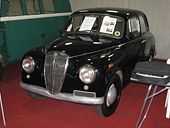Lancia Appia
| Lancia Appia | |
|---|---|
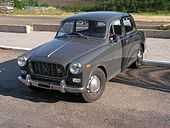 Lancia Appia 3rd series (1959-1963) | |
| Overview | |
| Manufacturer | Lancia |
| Production |
1953-1963 98,027 produced |
| Designer |
Pininfarina (Coupé) Giovanni Michelotti at Vignale (Convertible and Coupe Lusso)[1] Zagato (Sport, GT, GTS and GTE) |
| Body and chassis | |
| Class | Small family car |
| Body style |
4-door Berlina 2-door Coupé (Pininfarina) 2-door Coupé (Zagato) 2-door Coupé Lusso (Vignale) 2-door Convertible (Vignale) 3-door estate Viotti |
| Layout | FR layout |
| Related | Lancia Aurelia |
| Powertrain | |
| Engine | 1.1 L Lancia V4 engine |
| Dimensions | |
| Wheelbase |
2,480 mm (97.6 in) S.I 2,510 mm (98.8 in) S.II, S.III 2,350 mm (92.5 in) Sport |
| Length | 3,865 mm (152.2 in) |
| Width | 1,420 mm (55.9 in) |
| Height | 1,422 mm (56.0 in) |
| Curb weight | 820 kg (1,808 lb)-920 kg (2,028 lb) |
| Chronology | |
| Predecessor | Lancia Ardea |
| Successor | Lancia Fulvia |
The Lancia Appia (Tipo 808/809/812) was a car introduced in 1953 as a replacement for the Ardea and in production for 10 years. The Appia was the last in a long line of Lancia production cars dating back to the Lancia Lambda (introduced in 1922) to use the famous sliding pillar front suspension.[2] All three series produced had a V4 engine of 1089 cc.
In addition to the saloons, a number of special bodied Appias were produced, including a Coupe by Pininfarina, a convertible and Coupe Lusso by Vignale and an aluminium bodied GT by Zagato.
The Appia was renowned for its high quality and simple engineering refinement, which helped it gain a deserved reputation for reliability and longevity. When leaving the factory they would originally fit Pirelli Cinturato 155HR15 tyres (CA67).
Often overlooked by classic car enthusiasts (and the press) in favour of its more prestigious stable mates the Aurelia and Flaminia, those who own and run these cars know that they are equally deserving of recognition and preservation.
Three series of Appia were built:
- 1st series, produced between 1953 and 1956. Only sedan (Berlina) body style built, similar style to the Aurelia.
- 2nd series, produced between 1956 and 1959. Longer wheelbase, different boot and higher engine power.
A sportier 2-door version was also available.
- 3rd series, produced between 1959 and 1963. New front end with new horizontal grille and lower bonnet line and more engine power.
Approximately 98,000 Appias were built as Berlinas, 3,900 as commercial vehicles and 5,161 supplied to coachbuilders.
Engines
The Appia has a V4 engine with a 10.2° cylinder angle and a single head for all 4 cylinders.
| Model | Production years | Engine | Displacement | Power | Fuel system |
|---|---|---|---|---|---|
| Berlina S.I | 1953-56 | V4 OHV | 1089 cc | 38 hp | Single carburetor |
| Berlina S.II | 1956-59 | V4 OHV | 1089 cc | 43 hp | Single carburetor |
| Berlina S.III | 1959-63 | V4 OHV | 1089 cc | 48 hp | Single carburetor |
| Coupé, Cabrio | 1956-63 | V4 OHV | 1089 cc | 53 hp | Single carburetor |
| GTS | 1956-58 | V4 OHV | 1089 cc | 58 hp | Single carburetor |
| Sport | 1960-63 | V4 OHV | 1089 cc | 60 hp | Single carburetor |
C10
Sedan-version C10 was introduced in April 1953 at the Turin Motor Show. The body style was similar to the sister model Aurelia. At the Geneva Motor Show in March 1956 the second series was introduced with 3 centimetres (1.2 in) longer wheelbase and a modernized body. In March 1959 the third series was introduced at the Geneva Motor Show with new front end, inspired by the Flaminia. Between 1960 and 1962 a three-door estate version was built by Viotto, it was called as Giardinetta.
Commercial variants
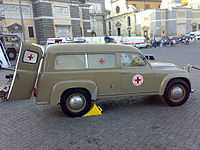
Lancia also built light commercial bodies on the Appia chassis: the Furgoncino (Van), Camioncino (pick-up) and an ambulance version the Autolettiga.
Coupé
Pininfarina built a coupé version between 1957 and 1963. 302 second series cars were made at Pininfarina. Some 785 third series cars were also coachbuilt by Carrozzeria Viotti due to lack of production capabilities at Pininfarina's factory. 1,087 cars were built overall.
Convertible and Coupé Lusso
Vignale built a cabriolet version between 1957 and 1963. Styled by Giovanni Michelotti, it was first built on a second series Appia platform with a 53 bhp engine. Later it was slightly re-styled with the fitment of a rear seat and produced on the third series platform fitted with the more powerful 60 bhp engine. From 1957 to 1962 1,584 convertibles were built in two series: the first series cars were two seaters while the later cars were 2+2 seaters.[1]
Between 1959 and 1961 the Coupé Lusso, derived from Lancia Gran Lusso prototype, was also available with same designer as the Vignale cabriolet.[1] 477 Appias were bodied in the Vignale factory on series 3, Tipo 812.02, Appia platform.
GT/GTS/GTE
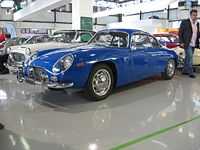
Zagato built 4 coupé versions based on the Berlina between 1957 and 1962.
- GT same engine as Pininfarina and Vignales models.
- GTS more powerful engine.
- GTE Gran Turosmo Esportazione had modified body with headlamps mounted high and back.
521 total of GT, GTS and GTE built.
Sport
Zagato built around 200 Sport SWB cars on the Appia chassis. A Lancia Appia Zagato was raced in the 1959 12 Hours of Sebring, among the drivers was newsman Walter Cronkite.[3]
Giardinetta
Carrozzeria Viotti built a 3-door estate based on Tipo 808.21 Appia platform. Total of 300 were made.
Performance
An S1 Berlina saloon tested by the British The Motor magazine in 1954 had a top speed of 76.1 mph (122.5 km/h) and could accelerate from 0-60 mph (97 km/h) in 32.5 seconds. A fuel consumption of 29.0 miles per imperial gallon (9.7 L/100 km; 24.1 mpg-US) was recorded. The car was not at the time available on the UK market but an Italian price of 1,328,600 Lire was reported (converted to £780).[4]
Model gallery
-
Lancia Appia Berlina 1st series (1953)
-
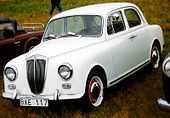
Lancia Appia Berlina 2nd series (1958)
-
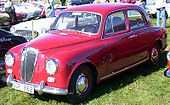
Lancia Appia Berlina 1959
-
Lancia Appia Berlina 3rd series
-

Lancia Appia Pininfarina Coupé Series II
-

Lancia Appia GT Zagato
References
- ↑ 1.0 1.1 1.2 "Registro Vignale". vignale.org.
- ↑ Setright, L. J. K. (1976). "Overdrive". In Ian Ward. Anatomy of the Motor Car. Orbis. p. 159. ISBN 0-85613-230-6.
- ↑ McCluggage, Denise (August 24, 2009). "That's the Way It Was". AutoWeek 59 (17): 15.
- ↑ "The Lancia Appia". The Motor. January 27, 1954.
- Lancia by Michael Frostick, 1976. ISBN 0-901564-22-2
External links
| Wikimedia Commons has media related to Lancia Appia. |
- Lancisti.net - An Information Exchange and Support Community for Lancia Owners and Enthusiasts
- Lancia Motor Club (UK)
- Lancia Appia Zagato data
| |||||||||||||||||||||||||||||||||||||||||||||||||||||||||||||
| « previous — Lancia Automobiles S.p.A., a subsidiary of the Fiat S.p.A. since 1969, car timeline, 1940s–1980s — next » | ||||||||||||||||||||||||||||||||||||||||
|---|---|---|---|---|---|---|---|---|---|---|---|---|---|---|---|---|---|---|---|---|---|---|---|---|---|---|---|---|---|---|---|---|---|---|---|---|---|---|---|---|
| Type | 1940s | 1950s | 1960s | 1970s | ||||||||||||||||||||||||||||||||||||
| 0 | 1 | 2 | 3 | 4 | 5 | 6 | 7 | 8 | 9 | 0 | 1 | 2 | 3 | 4 | 5 | 6 | 7 | 8 | 9 | 0 | 1 | 2 | 3 | 4 | 5 | 6 | 7 | 8 | 9 | 0 | 1 | 2 | 3 | 4 | 5 | 6 | 7 | 8 | 9 | |
| Small family car | …Ardea | Appia | Fulvia | |||||||||||||||||||||||||||||||||||||
| Large family car | …Aprilia | Flavia I | Beta | |||||||||||||||||||||||||||||||||||||
| Executive car | Aurelia | Flaminia | 2000 | Gamma | ||||||||||||||||||||||||||||||||||||
| Coupé | Fulvia Coupé / Sport | |||||||||||||||||||||||||||||||||||||||
| Flavia I/2000 | Beta Coupé / Spider / Montecarlo | |||||||||||||||||||||||||||||||||||||||
| Aurelia | Flaminia | Gamma Coupé | ||||||||||||||||||||||||||||||||||||||
| Sports car | Stratos | |||||||||||||||||||||||||||||||||||||||
| Racing car | D20 D23 D24 D25 | D50 | Montecarlo Turbo | |||||||||||||||||||||||||||||||||||||
